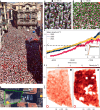Emergence of collective oscillations in massive human crowds
- PMID: 39910390
- PMCID: PMC11798876
- DOI: 10.1038/s41586-024-08514-6
Emergence of collective oscillations in massive human crowds
Abstract
Dense crowds form some of the most dangerous environments in modern society1. Dangers arise from uncontrolled collective motions, leading to compression against walls, suffocation and fatalities2-4. Our current understanding of crowd dynamics primarily relies on heuristic collision models, which effectively capture the behaviour observed in small groups of people5,6. However, the emergent dynamics of dense crowds, composed of thousands of individuals, remains a formidable many-body problem lacking quantitative experimental characterization and explanations rooted in first principles. Here we analyse the dynamics of thousands of densely packed individuals at the San Fermín festival (Spain) and infer a physical theory of dense crowds in confinement. Our measurements reveal that dense crowds can self-organize into macroscopic chiral oscillators, coordinating the orbital motion of hundreds of individuals without external guidance. Guided by these measurements and symmetry principles, we construct a mechanical model of dense-crowd motion. Our model demonstrates that emergent odd frictional forces drive a non-reciprocal phase transition7 towards collective chiral oscillations, capturing all our experimental observations. To test the robustness of our findings, we show that similar chiral dynamics emerged at the onset of the 2010 Love Parade disaster and propose a protocol that could help anticipate these previously unpredictable dynamics.
© 2025. The Author(s).
Conflict of interest statement
Competing interests: The authors declare no competing interests.
Figures















References
-
- Feliciani, C., Shimura, K. & Nishinari, K. Introduction to Crowd Management: Managing Crowds in the Digital Era: Theory and Practice (Springer, 2022).
-
- Feliciani, C., Corbetta, A., Haghani, M. & Nishinari, K. Trends in crowd accidents based on an analysis of press reports. Saf. Sci.164, 106174 (2023).
-
- Helbing, D., Johansson, A. & Al-Abideen, H. Z. Dynamics of crowd disasters: an empirical study. Phys. Rev. E75, 046109 (2007). - PubMed
-
- Helbing, D. & Mukerji, P. Crowd disasters as systemic failures: analysis of the Love Parade disaster. EPJ Data Sci.1, 7 (2012).
-
- Corbetta, A. & Toschi, F. Physics of human crowds. Annu. Rev. Condens. Matter Phys.14, 311–333 (2023).
MeSH terms
LinkOut - more resources
Full Text Sources

